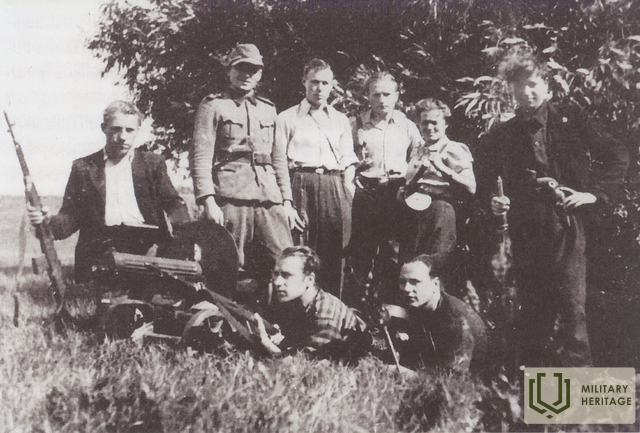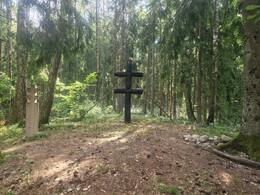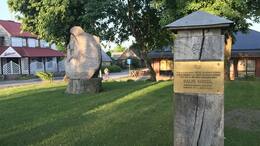Hawks III National Partizans

"Vanagai" was an armed unit of the Lithuanian Freedom Army (LLA), created on 20 July 1944 by Order No. 21, when the LLA was divided into two sectors: organizational (OS) and operational (VS, "Vanagai"). This division clearly defined the status and functions of the organization's members - OS members lived legally and performed auxiliary functions (supply, intelligence), while "Vanagai" operated as partisan units performing the functions of the regular army, fighting positional or partisan warfare.
One of the famous "Vanagas" camps was located in the Plokštinė forest, near Lake Plateliai. In the summer of 1944, as the Germans retreated and the Red Army approached, young people from all over Lithuania, especially Samogitia, came here for LLA training. Strict military discipline was maintained in the camp: they got up at 5-6 in the morning, washed in Lake Plateliai, and sang the Lithuanian anthem in the evenings. The basics of military training were taught by LLA officers-instructors Butrimaitis and Strimaitis. Shooting exercises took place near the Jakumas stream, where targets were installed on a thick pine tree. The "Vanagas" took the oath near Lake Plateliai.
The camp territory occupied an area of about 1.5 hectares. The partisans lived in cloth and canvas tents, covered with spruce branches. At first they ate the food they brought, later they received products from farmers in the surrounding villages, one of whom even donated a cow. Two underground cellars were equipped in the camp: one for weapons, the other for storing food.
In 2019, during archaeological research, 502 finds were found at the campsite, of which 414 were transferred to the Kretinga Museum. The findings were dominated by nails used to attach tent pegs, Russian and German ammunition, parts of weapons, parts of explosives, equipment, uniforms and clothing details, and various household items. Details of Wehrmacht army uniforms confirmed that some of the camp participants wore uniforms taken over from German soldiers. The "Hawks" mainly used Russian 7.62 x 54R mm caliber (Mosin carbine, SVT semi-automatic rifle) and German 7.92 x 57 mm caliber (Mauser carbine) cartridges. There were also one or two German anti-tank guns in the camp.
The LLA and its "Vanagi" unit suffered greatly in 1944-1945. - On December 28, 1944, the LLA's supreme commander Kazys Veverskis was killed, and in December 1945, the high command headquarters, led by Gen. Motiejus Pečiulionis, was liquidated. Despite this, in 1946 the LLA still had many lower-ranking commanders, structures and members. The organization, together with other resistance groups, later merged into the structures of the Lithuanian Freedom Struggle Movement (LLKS).
More information sources
Related timeline
Related objects
Lithuanian Freedom Army partisan "Vanagi" training and shooting camp in Plokštinė
A Lithuanian Freedom Army (LLA) partisan training and shooting camp, known as the "Vanagai" camp, was established in Samogitia, in the Plokštinė forests, near Plateliai. This camp was an important part of the LLA structure, where partisans prepared for the fight against the Soviet occupation authorities.
The camp was established in August 1944, when the Soviet Union occupied Lithuania for the second time. The members of the "Hawks" group studied here not only shooting and guerrilla warfare tactics, but also survival skills in nature. They were preparing for long-term resistance in the forests in order to be able to operate covertly and organize attacks on Soviet structures as effectively as possible. The camp taught not only armed resistance, but also reconnaissance, communication, camouflage and other skills necessary for partisans.
The forests of Plokštīne were chosen for their density and remoteness – this area allowed the partisans to hide from the occupiers. The camp’s activities eventually covered the surrounding forests with complex partisan trails that were difficult for the Soviets to understand for a long time. Men and women of all ages trained here, including former riflemen, soldiers and ordinary Lithuanian residents, ready to fight for Lithuania’s freedom.
In 2019, the exact location of the "Hawks" military training on August 15–25, 1944, was determined in the Plokštinė forest, which was confirmed by the details of the stories of many presenters - participants of the military training camp, and new, previously unknown data was accumulated about the camp's equipment and the daily life of the "Hawks" who served there. The location was investigated by Gediminas Petrauskas.
Although there are no special signs dedicated to this camp when visiting the site, the past historical events are reflected in the still-found shells and bullets and their marks in the pine trees.
Monument to the Defenders of Lithuanian Freedom (Plateliai)
The monument to the Lithuanian Freedom Army (LLA) stands near the square of the town of Plateliai. It commemorates the resistance of the Lithuanian people, which began in July 1944, when the Soviet army entered Lithuania for the second time. During the active resistance, LLA soldiers gathered in the Plateliai forests in Samogitia on August 15 and established the Hawks organization.
The LLA was founded in December 1941 in Vilnius by Kazys Veverskis. It was a secret Lithuanian national-political organization whose goal was to fight for the independence of Lithuania, using not only diplomatic and political, but also military means. The ranks of the LLA included soldiers, riflemen, students, and ordinary Lithuanians who actively resisted the occupation.
In August 2004, to commemorate the 60th anniversary of the Vanagai military training camp in the Plateliai forests, the first monument to the Lithuanian Freedom Army in Lithuania was unveiled in the town at the initiative of Vytautas Urbikas and Albinas Klimas. Its author, the Samogitian sculptor Antanas Vaškys, created a monument made of field stone, 2.25 m high and 1.1 m wide, and carved the image of the warrior and the inscription: “Lithuanian Freedom Army 1941–1944–1953. Lithuanians’ fight for freedom is eternal.” The sculptor ensured that this monument would stand for as long as 500 years.






